Role of ERalpha in the differential response of Stat5a loss in susceptibility to mammary preneoplasia and DMBA-induced carcinogenesis
- PMID: 20181624
- PMCID: PMC2878361
- DOI: 10.1093/carcin/bgq048
Role of ERalpha in the differential response of Stat5a loss in susceptibility to mammary preneoplasia and DMBA-induced carcinogenesis
Abstract
Deregulated estrogen signaling is evidently linked to breast cancer pathophysiology, although the role of signal transducer and activator of transcription (Stat)5a, integral to normal mammary gland development, is less clear. A mouse model of mammary epithelial cell-targeted deregulated estrogen receptor alpha (ERalpha) expression [conditional ERalpha in mammary epithelium (CERM)] was crossed with mice carrying a germ line deletion of Stat5a [Stat5a-/-] to investigate interactions between ERalpha and Stat5a in mammary tissue. CERM, CERM/Stat5a+/-, CERM/Stat5a-/-, Stat5a+/-, Stat5a-/- and wild-type (WT) mice were generated to test the roles of ERalpha and Stat5a on pubertal differentiation and cancer progression with and without exposure to the chemical carcinogen 7,12-dimethylbenz[a]anthracene (DMBA). Only CERM/Stat5a-/- mice demonstrated delayed pubertal terminal end bud differentiation. Without DMBA exposure, Stat5a loss abrogated ERalpha-initiated hyperplastic alveolar nodule (HAN) development and, similarly, Stat5a-/- mice did not develop HANs. However, although Stat5a loss still reduced ERalpha-initiated HAN prevalence following DMBA exposure, Stat5a loss without deregulated ERalpha was associated with an increased HAN prevalence compared with WT. Progression to ERalpha(+) and ERalpha(-) adenocarcinoma was found in all CERM-containing genotypes (CERM, CERM/Stat5a+/-, CERM/Stat5a-/-) and ERalpha(+) adenocarcinoma in the Stat5a-/- genotype. The mammary epithelial cell proliferative index was increased only in CERM mice independent of Stat5a loss. No differences in apoptotic indices were found. In summary, Stat5a cooperated with deregulated ERalpha in retarding pubertal mammary differentiation and contributed to ERalpha-initiated preneoplasia, but its loss did not prevent development of invasive cancer. Moreover, in the absence of deregulated ERalpha, Stat5a loss was associated with development of both HANs and invasive cancer following DMBA exposure.
Figures
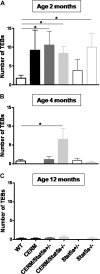
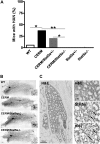
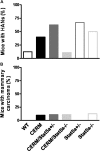
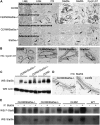
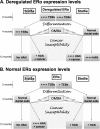
Similar articles
-
Assessing estrogen signaling aberrations in breast cancer risk using genetically engineered mouse models.Ann N Y Acad Sci. 2011 Jul;1229(1):147-55. doi: 10.1111/j.1749-6632.2011.06086.x. Ann N Y Acad Sci. 2011. PMID: 21793850 Free PMC article. Review.
-
7,8-Dihydroxycoumarin exerts antitumor potential on DMBA-induced mammary carcinogenesis by inhibiting ERα, PR, EGFR, and IGF1R: involvement of MAPK1/2-JNK1/2-Akt pathway.J Physiol Biochem. 2018 May;74(2):223-234. doi: 10.1007/s13105-018-0608-2. Epub 2018 Feb 12. J Physiol Biochem. 2018. PMID: 29435821
-
Characterization of a preclinical model of simultaneous breast and ovarian cancer progression.Carcinogenesis. 2007 Jan;28(1):130-5. doi: 10.1093/carcin/bgl140. Epub 2006 Aug 3. Carcinogenesis. 2007. PMID: 16891317
-
Inhibition of mammary gland tumors by short-term treatment of estradiol-3-benzoate associated with down-regulation of estrogen receptor ERalpha and ERbeta.Oncol Rep. 2004 Oct;12(4):689-93. Oncol Rep. 2004. PMID: 15375486
-
Prognostic factors in MNU and DMBA-induced mammary tumors in female rats.Pathol Res Pract. 2017 May;213(5):441-446. doi: 10.1016/j.prp.2017.02.014. Epub 2017 Feb 24. Pathol Res Pract. 2017. PMID: 28285967
Cited by
-
Signal transducer and activator of transcription 5 as a key signaling pathway in normal mammary gland developmental biology and breast cancer.Breast Cancer Res. 2011 Oct 12;13(5):220. doi: 10.1186/bcr2921. Breast Cancer Res. 2011. PMID: 22018398 Free PMC article. Review.
-
Assessing estrogen signaling aberrations in breast cancer risk using genetically engineered mouse models.Ann N Y Acad Sci. 2011 Jul;1229(1):147-55. doi: 10.1111/j.1749-6632.2011.06086.x. Ann N Y Acad Sci. 2011. PMID: 21793850 Free PMC article. Review.
-
Rat Models of Hormone Receptor-Positive Breast Cancer.J Mammary Gland Biol Neoplasia. 2024 Jun 24;29(1):12. doi: 10.1007/s10911-024-09566-0. J Mammary Gland Biol Neoplasia. 2024. PMID: 38913216 Free PMC article. Review.
-
Essential role of STAT5a in DCIS formation and invasion following estrogen treatment.Aging (Albany NY). 2020 Aug 5;12(14):15104-15120. doi: 10.18632/aging.103586. Aging (Albany NY). 2020. PMID: 32633727 Free PMC article.
-
Oestrogen receptor-alpha regulates non-canonical Hedgehog-signalling in the mammary gland.Dev Biol. 2014 Jul 15;391(2):219-29. doi: 10.1016/j.ydbio.2014.04.007. Epub 2014 Apr 21. Dev Biol. 2014. PMID: 24769368 Free PMC article.
References
-
- Speirs V, et al. New perspectives into the biological and clinical relevance of oestrogen receptors in the human breast. J. Pathol. 2007;211:499–506. - PubMed
-
- Allred DC, et al. Biological features of premalignant disease in the human breast. J. Mammary Gland Biol. Neoplasia. 2000;5:351–364. - PubMed
-
- Kuerer HM, et al. Ductal carcinoma in situ: state of the science and roadmap to advance the field. J. Clin. Oncol. 2009;27:279–288. - PubMed
-
- Medina D. Premalignant and malignant mammary lesions induced by MMTV and chemical carcinogens. J. Mammary Gland Biol. Neoplasia. 2008;13:271–277. - PubMed
-
- Allred DC, et al. The relevance of mouse models to understanding the development and progression of human breast cancer. J. Mammary Gland Biol. Neoplasia. 2008;13:279–288. - PubMed
Publication types
MeSH terms
Substances
Grants and funding
LinkOut - more resources
Full Text Sources
Molecular Biology Databases
Miscellaneous

